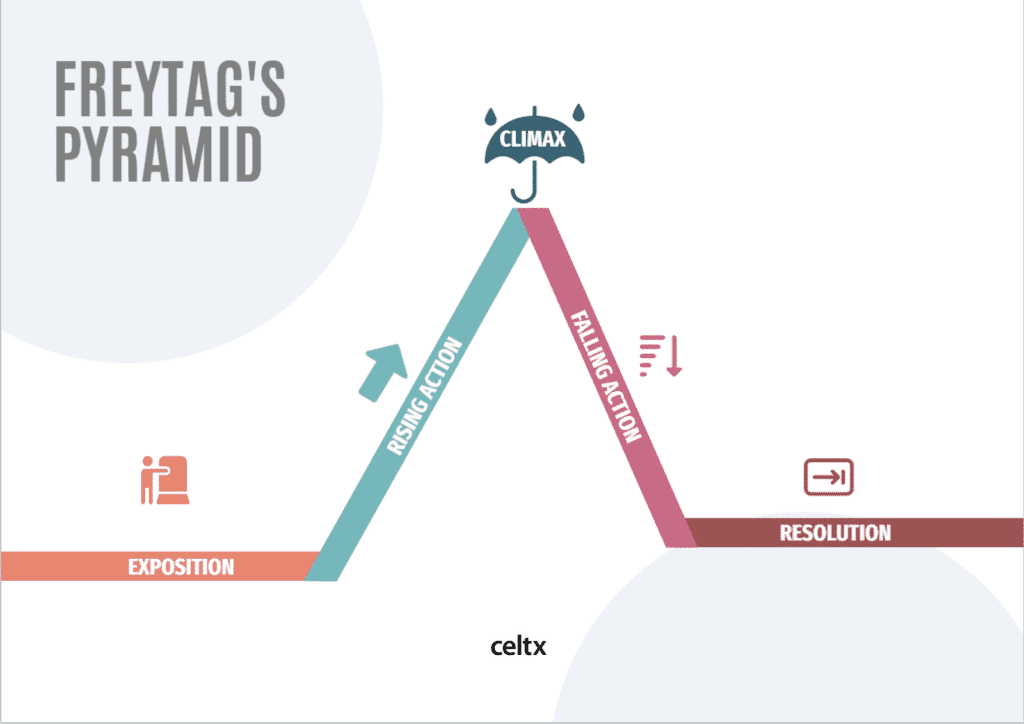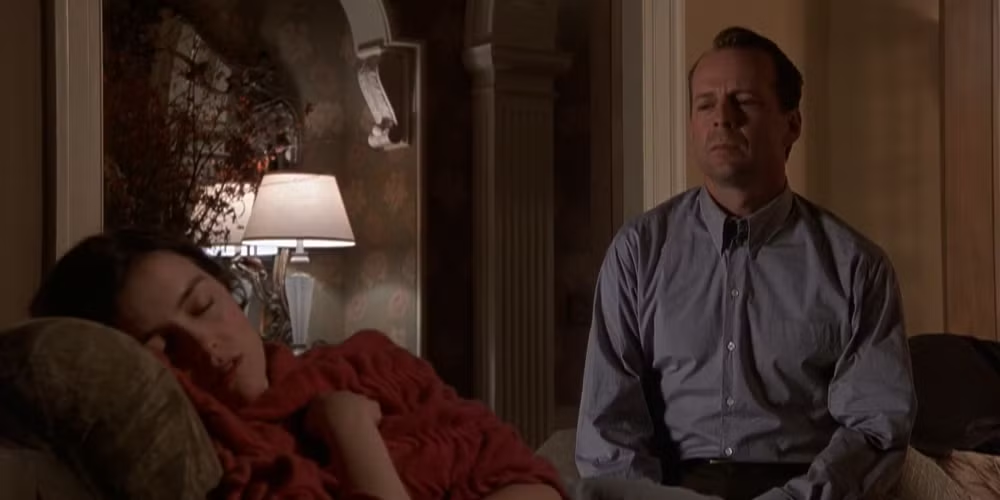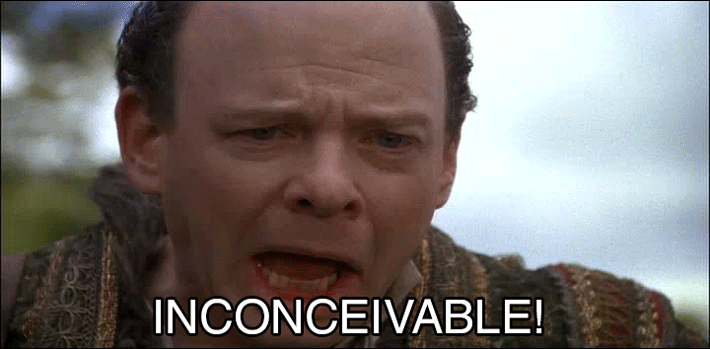
There’s a moment in every story where everything changes for better or for worse. This is called the climax.
It’s the most emotionally charged, intense, or exciting part of the plot before we dive into the story’s resolution. Therefore, it’s one of the most important!
While a well-written climax can make a story memorable, a stinker of a climax can leave an audience disappointed. Which is why we have created this guide!
In today’s blog, we will be exploring the definition of a story climax and how it differs from falling action as well as look at some killer examples that’ll surely keep you on the edge of your seat.
Plus, we’ll throw in some top tips on how you can create an engaging and exciting climax for your own story.
So, let’s get going…
What is the Climax of a Story?
The word ‘climax’ originates from the Greek klimax which means ‘ladder.’
Often appearing near the end of a story’s third act, the climax is where we reach the highest point of tension, stakes, or excitement. It’s a story’s turning point that signals the end of its central conflict and stakes, setting us up for either a positive ending or a disastrous one.
Climaxes can either be explosive, subtle, or somewhere in between but it must be a time where the protagonist faces their biggest challenge or makes an important decision that determines the story’s outcome.
In terms of character, a climax also signals the protagonist’s overall growth or change throughout the course of the narrative. It should be linked to the story’s inciting incident, so it can bring the narrative full circle and give your audience an impactful ending!
If a climax occurs too early in a story, it’s in danger of disengaging the audience. In contrast, if it occurs too late, the resolution may lack depth, leaving an audience unsatisfied.
Overall, the climax in a story triggers the payoff, designed to leave a lasting impression on the audience.
Climax vs. Falling Action: What’s the Difference?
To understand the difference between the climax and falling action, we need to first refer to the three-act structure.

Here, we see that the climax is just one element of the main plot arc, comprised of:
- Exposition
- Inciting Incident
- Plot Point #1
- Rising Action
- Midpoint
- Plot Point #2
- Pre-Climax
- Climax
- Resolution
The climax occurs partway through act three, at the highest point of conflict. The trajectory immediately after this point in the plot has occurred drops – this is what’s known as falling action.
Indicated by the blue arrow, falling action follows directly after the climax, leading the story towards its resolution. The action begins to wind down after the story’s most intense moment, providing a sense of closure to the story as a whole.
The falling action is often a time where loose ends are tied up and characters adapt to their lives as they now know them following the intense events of the climax.
We can also refer to Freytag’s Pyramid to pinpoint the climax. The falling action is clearer in this example, bringing the story to its conclusion.

For more on Freytag’s Pyramid and story structure, click here.
5 Types of Climaxes in Storytelling
Climaxes can come in all different shapes and sizes, depending on the genre, themes, and messaging of your story.
Let’s explore the five main climaxes and how they impact a story.
1. The Crisis
Often found in thrillers, high-stakes dramas and suspense stories, a crisis climax requires the protagonist to make a decision that will change the course of their life in one way or another.
This decision is often made under extreme circumstances, pushing the protagonist to the limit. They’re usually forced to choose between two equally dire or morally complex options.
Take Katniss Everdeen in The Hunger Games. She had to decide whether to play by the Capitol’s rules or defy them in the Games’ final moments.
Watch the nail-biting moment here:
2. The Catharsis
Here, the protagonist must finally overcome a major internal or external conflict they’ve been battling throughout the story. It’s this moment where we see their personal growth, a transformation or even redemption.
You’ll find the catharsis climax is common in coming-of-age stories and dramas.
Ebenezer Scrooge has a crucial moment of catharsis in A Christmas Carol where he finally realizes the true meaning of Christmas.

3. The Revelation
Just as the title suggests, a revelation climax is when a major secret is revealed. Everything the protagonist (and sometimes the audience!) thought they knew, is completely altered.
This type of climax is perfect for mysteries and thrillers where shocking truths redefine the story.
The first example that comes to mind is The Sixth Sense, where both the protagonist, Cole Sear and the audience discover that he’s been dead the entire time.

4. The Heroic
The heroic climax gives the protagonist an opportunity – to change for the better! Here, they rise to the challenge and take this opportunity, changing their life and the lives of those around them.
The choice they make is usually a selfless or courageous one but triggers a positive change. Just like Maximus in Gladiator who eventually chooses honor and justice over personal vengeance, even if it means he loses his life.

5. The Antiheroic
While the antiheroic climax presents a similar opportunity to his heroic counterpart, the outcome is very different. Instead, the protagonist refuses the opportunity, giving into their flaws and going down a destructive path.
A protagonist in this situation could simply refuse to change, or act out of self-interest, pride, or stubbornness. Either way, their decision leads to their ultimate defeat or they simply become stagnant.
This was the case for Michael Corleone in The Godfather Part II who had the opportunity to leave the mafia but ultimately decides to double down on his ruthless leadership and kill Fredo after he learns of his betrayal. The consequence of this decision? He ended up isolating himself from everyone he loved.
As you can probably tell, the antiheroic climax is common in tragedies and villainous arcs.
For some of the best plot twists in recent years, check out this awesome article from IndieWire.
You’ve got the big moments in mind. Now, let Celtx help you bring them to life with beat sheets.
Organize ideas, visualize your story, and capture your story in one visual gulp.
How to Write a Compelling Climax: 5 Key Tips
Okay, so we’ve covered what a story climax is, where it occurs within the plot, and the different types of climaxes. But how do you write a compelling climax for yourself?
Let’s find out! Here are our five top tips to get you started:
1. Start at the End
Yes, this doesn’t really make sense at first glance, as we would start a story at the beginning.
However, during the planning process, it’s a good idea to map out your ending first, so you have a clear end point to work towards with the beginning and middle of your story. You know where both your plot and character arcs will culminate.
To pinpoint your ending, make sure you focus in on your story’s core idea or question, which already has your ending! For example, will your protagonist succeed in landing their dream job, yes, or no? Or will they meet the love of their life, yes, or no?
Writer and script consultant Jill Chamberlain discusses the importance of the climax and the impact it has on storytelling:
2. Make it Personal
The climax should be rooted in the protagonist’s journey and should feel personally earned by them. In theory, you want your audience to predict what the climax will be and the decision that must be made.
You can drop hints and story elements along the way that allude to what could happen, narrowing the choices for your characters down until you reach the climax.
If the climax doesn’t relate directly to the journey the protagonist has taken, then your audience won’t resonate with it.

3. Don’t Make it Too Easy (Or Too Difficult!)
There is no story without conflict, so don’t make things too easy for your characters that the ending feels flat. The choice they must make at the climax needs to be a profound and life-altering one.
On the other hand, don’t make it too difficult. For example, it’s a little farfetched for someone to decide to fight an entire battalion single handedly to escape a prisoner of war camp successfully – unless of course, they have superpowers!
Strike a balance between the two!
4. Employ the Crucible Effect
This is when your character is between a rock and a hard place – literally, and they cannot escape. This could be within an environment or situation which forces a protagonist into the story climax where they’re under the most extreme pressure.
The character is left no choice but to make a choice (if that makes sense!) and stick to it, triggering an important change for them and the world around them.
5. Genre, Genre, Genre!
As we’ve seen earlier in the blog, genre has a huge role to play when it comes to the ins and outs of a story climax.
For example, if you’re writing a romantic comedy, you’ll most likely have a positive outcome. On the other hand, if you’re writing a tragedy, things will be very different!
Of course, there are no rules that say you must stick to these conventions, but it’s crucial that you’re aware of them and know what works, and what doesn’t.

Common Mistakes Writers Make When Writing a Climax (And How to Fix Them)
Unfortunately, even the best writers find themselves making mistakes – and that’s okay. What’s important is that you know how to fix them!
Here are some key things to look out for when you’re crafting your next story climax:
1. A Rushed Climax
While story climaxes can be explosive, they shouldn’t be rushed. As you plan your narrative, take the time to develop each scene individually, including the climax.
To help with your planning, consider these questions:
- Does each scene drive us towards the climax?
- Are you foreshadowing what is about to happen?

2. An Unbelievable Climax
Your climax should be grounded in your story world’s reality and not seem completely inconceivable. You’ve worked hard to world build and create believable characters, so don’t ruin it with a climax that seems physically impossible.

Instead, make sure the climax makes sense for the story and something your character has grown to be capable of, even if they don’t believe it themselves.
3. A Predictable Climax
While you should be leaving breadcrumbs as clues to the climax throughout your story, your audience shouldn’t see what’s coming down to the last detail.
As we’ve said, your climax should be alluded to throughout the narrative, giving the audience time to process everything, and leave them with a satisfying payoff.
Conclusion
A well-crafted climax is the heart of any compelling story, offering the payoff to all the tension, stakes, and character development built throughout the narrative.
Whether your climax is a thrilling crisis, a powerful catharsis, or a shocking revelation, it should feel both inevitable and surprising, leaving a lasting impact on your audience.
By carefully structuring your story, making the climax personal to your protagonist, and balancing challenges with believable resolutions, you can create a moment that truly changes everything.
Keep experimenting, refining, and pushing your characters to their limits, because a great climax can turn a good story into an unforgettable one.
Focus on your story, not your formatting.
Let Celtx’s Script Editor automatically apply all industry rules while you focus on the story.
For more on story development:
- Conflict & Resolution: How to Build Tension in Drama Scripts
- Hook, Hold, and Deliver: The Screenwriter’s Guide to Pacing
- Writing Subtext: How to Say More by Saying Less

